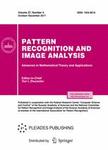版权所有:内蒙古大学图书馆 技术提供:维普资讯• 智图
内蒙古自治区呼和浩特市赛罕区大学西街235号 邮编: 010021

作者机构:Russian Acad Sci Fed Res Ctr Comp Sci & Control Bldg 244 Vavilov Str Moscow 119333 Russia
出 版 物:《PATTERN RECOGNITION AND IMAGE ANALYSIS》 (模式识别与图形分析)
年 卷 期:2020年第30卷第4期
页 面:638-654页
核心收录:
学科分类:08[工学] 0812[工学-计算机科学与技术(可授工学、理学学位)]
基 金:Russian Foundation for Basic Research [20-07-01031]
主 题:image analysis descriptive image analysis mathematical theory of image analysis automated information extraction from images image recognition descriptive algorithmic schemes models of image analysis procedures image representations image models image recognition algorithms mathematical structures information structures formal systems
摘 要:This article is the fourth in a series of publications devoted to the state of the art and prospects for developing Descriptive Image Analysis, one of the leading and intensively developing fields of modern mathematical image analysis theory. The fundamental problem discussed in the article is to automate information extraction from images necessary for making intelligent decisions. This study is devoted to regularizing the generation of descriptive algorithmic image analysis and recognition schemes. The main result is the definition of a new mathematical structure with the following functional capabilities: 1) solution of an image recognition problem in a given formulation, with given initial data and a scenario that determines the sequence of application of information processing procedures and their iterative loops;2) construction of descriptive algorithmic schemes for solving a problem with given initial data in the absence of a given scenario;in the case of a successful solution, the fixation of the sequence of procedures and information processing loops that yielded its solution governs the corresponding descriptive algorithmic schemes and scenarios that can be further used to solve the corresponding class of image recognition problems;3) comparative analysis and optimization of methods for solving image recognition problems via their realization as descriptive algorithmic schemes and scenarios allowed by the structure. The introduced structure is a tool for representing and implementing information processing while solving an image recognition problem for arbitrary formulations, scenarios, models, and solution methods;it can also emulate any descriptive algorithmic scheme and combinations thereof, which are used and generated when solving an image recognition problem. The introduced structure is interpreted as a fundamental model for generating and emulating image recognition procedures. A type characteristic of the introduced information structure for genera